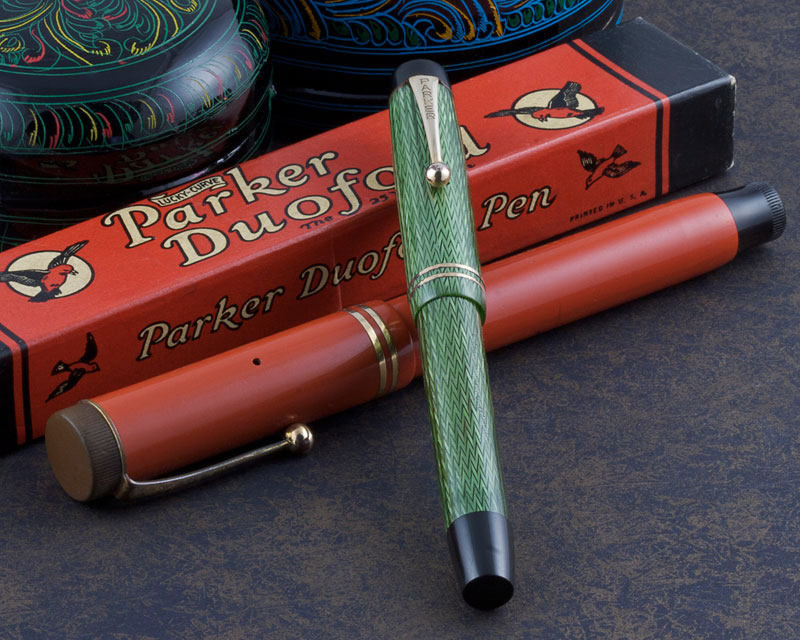PenHero 365: Parker Duofold Junior (UK)
by Jim Mamoulides, February 8, 2010

Parker Duofold Junior (UK) Green and Black Herringbone fountain pen open c1941-1945
One of the most stunning pens I own came to me from winning an eBay auction titled simply, "Green Parker Pen." The fuzzy photo only hinted at the vivid green and black herringbone celluloid material the cap and barrel was made from. I have only seen one other example of this material and it was on a full size Duofold from the UK, and fetched a handsome price. I was very happy to have captured this diminutive pen for the price I paid.
Parker began making button filling Duofold pens in the UK in 1941. The pens were based on the streamlined Duofold design Parker made in the USA from 1929 through 1932. The first pens were assembled at the Parker Newhaven, UK factory from parts made in Canada. The first parts made at Newhaven were Duofold nibs, which were stamped "N" on the bottom imprint line. The Parker Newhaven factory made four sizes of Duofolds, Senior, Special, Junior and Lady, all similar in dimensions to the final USA and Canadian streamline Duofold production. The line was made from 1941 through 1944. It's as if Parker had wound the clock back ten years.

Parker Duofold Junior (UK) Green and Black Herringbone fountain pen closed c1941-1945, with full size Duofold for comparison
Of particular interest to collectors is that the UK made Duofolds were made in a much larger choice of materials than pens made in the USA or Canada. There were at least twelve different pearl marbled finishes, several crosshatches, lizard skins, muted marbles, herringbones, lapis and solid colors. Only the red, black and blue / black lapis lazuli colors replicated from the USA made pens. There were three herringbone finishes: green and black, rose and black, and brown and black, which was made from a sheet of the celluloid material bent either into a straight tube or twisted in a helical fashion to form the cap and barrel tube. There are actually more colors than catalogued and Parker may have made other finishes, which only makes collecting UK made Duofolds more challenging and interesting.

Parker Duofold Junior (UK) Green and Black Herringbone fountain pen open c1941-1945
When I got this pen, I was surprised that it was practically in mint condition. There was some typical brassing on the clip ball and cap bands, but the herringbone celluloid was just about perfect.
This Parker Duofold Junior (UK) Green and Black Herringbone fountain pen is a very petite and light weight pen, weighing 0.5 ounce and being 4 9/16 inches long with the cap on and 5 5/8 inches with the cap posted on the end of the barrel. These smaller Parker Duofold pens don't post very deeply and the cap feels like it could come off during writing, so I don't use it posted. It's meant for small hands, so I find it difficult to use on a regular basis.

Parker Duofold Junior (UK) Green and Black Herringbone fountain pen c1941-1945 nib detail
The Parker Duofold Junior uses the venerable Parker button filling system, introduced in 1916. The system was designed so that the pen barrel is unbroken, with no lever or other device to snag clothes and pockets. One does need to keep track of the blind cap so as not to lose it, and pens can be found in the field without them. The button filling system is very simple to use. The process is straightforward: remove the blind cap from the bottom of the barrel, dip the nib in ink, press the button once, count to ten, and remove the nib and wipe.
This Parker Duofold Junior is fitted with a firm fine, and puts a nice wet line on paper. The nib is very smooth, and a nice writer.

Parker Duofold Junior (UK) Green and Black Herringbone fountain pen c1941-1945 open and with blind cap removed showing fill button
There are so many different Parker Newhaven Duofolds, with four different models and more than twenty-five different finishes that a complete collection would take some work. Some of the finishes, especially the lizard skin and herringbones will be very pricey even if the pens are in only good condition. The thing to watch for in these pens is brassing of the plated trim. Avoid pens that show signs of the seams coming apart or warping. As with any Duofold, these pens are easy to get into working order, and any good pen repair person can handle the job.
Selected References
Parker Duofold, David Shepherd and Dan Zazove, © Copyright 2006, Surrenden Pens Limited, Brighton, UK
Discuss / Recommend what you read on PenHero.com
Follow us on Twitter: PenHero
Add a link to PenHero.com on your blog:
(Copy & paste code)
Please only use the photo provided. Use of other photos requires permission.
The provided link photo will change as we update the site.
Comments on this article may be sent
to the author, Jim Mamoulides
PenHero.com Bibliography
